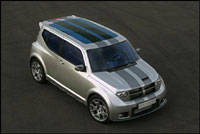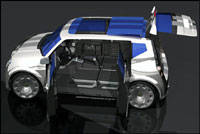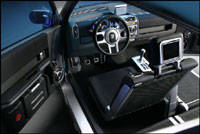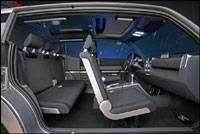Viper stripes on a subcompact? While these might at first seem a little over the top, the Hornet isn't all show and no go. In fact, it's got a fair amount of
 |
| 170-hp supercharged inline-four is more than enough for the Hornet to earn its wings and Viper stripes.(Photo: DaimlerChrysler Canada) |
go under its stout 'n stubby hood. A 1.6-litre overhead cam engine has been supercharged to make 170-horsepower and 165 lb-ft of torque, stellar numbers for this class. While DCX hasn't said where the engine was sourced, I'm almost certain that it's the same powerhouse unit fitted to MINI's Cooper S, which in itself was developed partially by Chrysler for use in everything from Neons and PT Cruisers, to MINIs and Rovers. Regardless of its origins, mated to a six-speed manual gearbox the Hornet is able to zing to 100 km/h in 6.7 seconds before reaching a top speed of 210 km/h (130 mph). By comparison, that's on par with what the much-lauded MINI Cooper S can do, which in itself is one capable vehicle.
All
 |
| The original Hornet didn't look anything like this. Mind you, it was nowhere as cool. (Photo: DaimlerChrysler Canada) |
things considered, there's almost no surprise in the reasoning behind why Dodge named this car the Hornet. Without getting too punny, its engine has a decent amount of sting to it, and it packs quite a wallop considering its diminutive size (by Dodge standards), and not to mention the fact that it's sure to cause a buzz at its launch. The Hornet also has some historical relevance, from the '50s era Hudson Hornet to the AMC Hornet, a '70s era "compact" which was available with V8 power, no less, and fell into Chrysler's hands when it took over American Motors to claim Jeep as its own. Today, the flying, stinging insect name works with Dodge's SuperBee products, such as the Ram and Charger SRT-8.
Getting back to the car itself, access to the interior is through four
 |
| Hornet puts the fun back into functional. Hornet also puts the street-racer into 'functional' even though the two were mutually exclusive entities. (Photo: DaimlerChrysler Canada) |
doors, two of which are rear-hinged for easy entry with an integrated B-Pillar. Who are we kidding; this style of door is popular at the moment, and would be great to see on any forthcoming product; subcompact, compact, midsize or SUV. The Hornet also gets neat-looking 'floating' seats trimmed in special Pique cloth, and a cantilever-style armrest that folds to provide clear access to the console-mounted shift-knob. The centre console's main elements - the navigation system, HVAC and stereo controls - feature chunky, tactile controls which mimic exterior styling. The grouped instrument cluster and thick-rimmed, tuning-fork spoke steering wheel also promote the Hornet's sporting image.
Aside
 |
| Adjustable bench slides back and forth, or folds flat turning the Hornet into a serious cargo hauler. (Photo: DaimlerChrysler Canada) |
from the styling of the vehicle inside and out, things get pretty funky concerning the interior's layout. Five can be carried comfortably aboard, and the rear 60/40 split bench slides on castors to free up an additional 225 mm (8.9 inches) of space for long-legged passengers. Aside from the driver's seat, everything folds flat, turning the Hornet into a very spacious cargo-hauler, while, for extra tall objects, the rear seats can be folded flush against the tailgate, an enhanced version of what's fitted to the Honda Fit. With such a tall body and spacious interior volume, the Hornet's clever flexible seating allows lounge-style relaxation, promoting its use as a lifestyle vehicle. Other neat touches to the interior include detachable cubbies with bungee cords to help keep smaller items at bay, plus a drink-cooling cupholder and fold-out trays.






